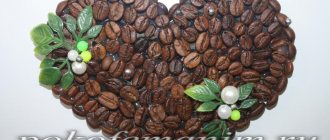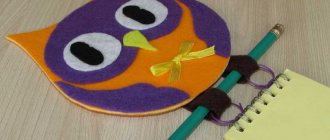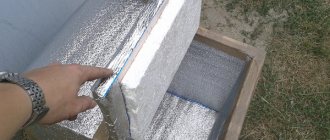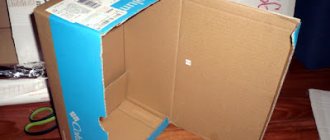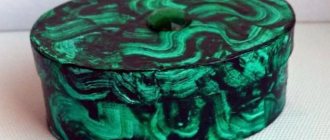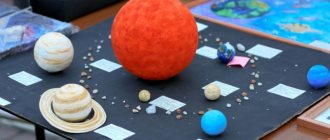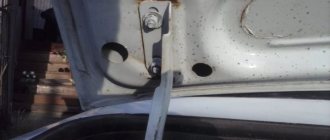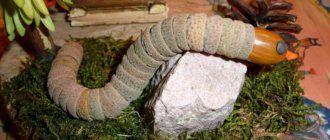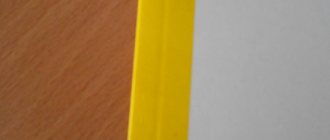A handmade craft is filled with the incredible positive energy of the master, his mood and good thoughts. This means that a home refrigerator magnet, made with your own hands, will become an emitter of warmth, kindness and positivity. They make it funny for a friend, for parents - with words of gratitude, for a loved one - with a declaration of love.
But not everyone knows how to make a refrigerator magnet with their own hands at home. It’s easy to make, the main thing is to have the desire and follow some rules.
How to make a magnet with your own hands
First, you need to come up with a theme and idea for the future magnet. Next, decide on the choice of magnet holder:
- ferrite - a hard magnet, round or square, will last 10 years, suitable for products made of light materials;
- vinyl – soft, produced in the form of a flexible plate on which a thin layer of glue is applied; used for small weight crafts;
- neodymium - withstands loads, does not lose its properties for decades, suitable for crafts with filling.
In order for the product to hold well, the adhesion force of the magnet must be 2-2.5 times the weight of the souvenir. It is not necessary to buy a magnet; you can use an old one.
Required tools:
- brushes for glue and paints;
- glue intended for gluing plastic and wood;
- scissors.
Additionally, you may need a glue gun, a knife, and a measuring tape. If you need to sew parts onto a craft, you will need a needle and thread.
Armed with the necessary tools, they get to work. Then everything depends only on the imagination of the master: you can make an exclusive thing from any available material. You can work in any direction, knowing the basics of making crafts.
Advice! Crafts made in the same style look better.
Lesson 6. Magnets using papier-mâché technique
To create such magnets, you can use not only old newspapers and magazines. In the same way, you can create a collage from postcards or photographs.
You will need:
- magnets;
- round stamp with a diameter of 2.5 cm (or scissors);
- pieces of colored paper or clippings from magazines and newspapers;
- glue;
- double-sided adhesive tape;
- thin cardboard.
Cut out circles with a diameter of 2.5 cm from thin cardboard, and apply double-sided adhesive tape to each.
Cut colored paper or magazine clippings into small pieces and start gluing them onto cardboard circles, placing the pieces close to each other, sometimes gluing one on top of the other. Trim the overhanging edges to give them a smooth round shape, then cover the pieces with one or two layers of glue and leave to dry.
Glue a magnet on the back side. Ready!
"Live" magnet made from cork
Make a hole in the wine cork with a knife, being careful not to damage the walls. A magnet is glued to the cork.
When the glue has dried, dry soil is poured into the hole and a small shoot of the plant or its seed is planted and watered.
Hang the magnet on the refrigerator on the sunny side. When there is not enough space for the plant, transplant it into a pot, and a new seedling is planted in its place.
Advice! Lately, growing microgreens has become fashionable. It is convenient to germinate wheat, lentils and barley in a cork.
Flower bouquet
In a craft store they buy flowers, leaves, curly branches and make a composition:
- Option 1. A frame for a future basket is cut out of a small calendar. Corrugated cardboard is glued onto it and painted with acrylic paint. A bouquet is created on the basket by attaching decorations. Foamiran is glued to the back side, and magnetic vinyl is placed on it.
- Option 2. Instead of a basket, a tree trunk is cut out of cardboard, painted with acrylic paint and varnished. The crown of the tree is decorated with flowers and leaves. When the glue dries, glue a strip of magnet onto the craft. If the bouquet turns out to be heavy, use a ferrite or neodymium magnet.
Flowers are also made independently. Using stamps, cut out petals and leaves from polymer clay or salt dough. After drying, the dough products are painted and varnished. Polymer clay is selected according to the desired color.
Magnets from caps and discs
CDs that are no longer needed will find a second life as decoration. A picture with a still life is glued to the surface of the disk, and a vinyl magnet is glued to the back side. You can paint the disc yourself. To do this, clean the surface with sandpaper, paint and draw.
Tin lids and crown caps are excellent materials for decoration. A photograph, landscape, words are inserted inside the lid. A magnet is glued to the back side, and the lid is varnished or painted.
If you glue the lid with the convex part up, first drawing cute faces on the surface, they will amuse others with their cool appearance.
Marking
Now you need to make the markings. Here it is worth showing precision and accuracy by dividing the square into its component parts.
First, mark lightly with a sharp knife. After making sure that all proportions are met, divide the square into geometric shapes (you can see the diagram in the photo).
Let the figures dry thoroughly. Turn them over several times a day to ensure they dry evenly.
In Russia they are asking to cancel the mandatory fee for choosing a seat on an airplane
A step-by-step recipe for making cute cakes with an original design and taste
They don't see water: unexpected things that are difficult for cats to do
Magnetic bags
A nice bag is made from thick fabric, filled with filling for volume, and tied with a ribbon. There is no need to glue the magnet to the bag; it is placed inside. The outer side is decorated with applique, beads, or a coin is glued on. This refrigerator magnet can be used as a talisman or to attract wealth.
"Coffee" magnets
There are countless ideas for creating a magnet from coffee beans and it’s easy to make. The basis is fabric, paper, wood or polymer. Cut out the desired part and glue coffee beans onto it.
As an option, they make an animal figurine, a heart model, or a photo frame.
Master class on creating the simplest “coffee” magnet:
- A heart template is cut out of cardboard. If made from plain paper, several layers are glued together.
- Glue the magnet in the center of the figure.
- Wrap the heart in fabric, gluing its edges.
- The product is tightly covered with coffee beans and covered with a layer of varnish.
The original “coffee” magnet is decorated with a bow and a beautiful souvenir is ready. For a friend who can't imagine a morning without a cup of coffee, this would be a great gift.
SubliMaster
In this article I want to tell you how you can make a cute magnet with a photo for your refrigerator. And not only produce it, but also sell it profitably.
My site was originally dedicated to sublimation printing. But this does not mean at all that you can make money only by selling mugs, plates, puzzles and other sublimation products. There are a lot of ideas! This includes thermal transfer and the production of watches with a photographic portrait and the printing of various calendars and much, much more.
In this section I will talk about all the ways of making and selling products that are NOT made using sublimation.
The first article is about magnets.
What attracts me most about making vinyl magnets is the simplicity (no equipment needed) and the amazing price tag. Judge for yourself - a magnet measuring 65 x 90 mm costs me less than 5 rubles. I sell it in kindergartens for 120 rubles!
Do you want too? Read on and find out everything, I have no secrets from you!
There are different magnets - plastic, metal, sunset ones. We will make a magnet based on magnetic vinyl. It looks like this:
In a nutshell, this is the most ordinary photograph pasted onto magnetic vinyl.
Choose any photo frame and insert a photo of the child. You can draw a photo frame yourself or download it from the Internet. Just don't forget about copyrights. Not all authors allow you to make money from their frameworks and templates.
To make a magnet we need the simplest tools:
This is a small piece of glass, a stationery knife and a metal ruler. And it's all? - you ask! Yes, this is enough to make good money. You don't even have to have your own printer. You can always order photo printing on the side. And your magnets will not become much more expensive. We'll calculate everything later.
A few words about magnetic vinyl. It is sold in rolls, usually 30 meters. Such a roll is not only quite expensive, but also very heavy. And this increases the cost of delivery for those who order vinyl by mail or through a transport company. Those who have the Zenon company nearby are luckier - they will sell at least half a meter of magnetic vinyl. Agree, this is very convenient.
Magnetic vinyl comes in different thicknesses. I recommend purchasing vinyl no thinner than 0.7 mm to make magnets. Magnets made from thinner vinyl look cheap and not solid.
Magnetic vinyl also comes with an adhesive layer and without an adhesive layer. With an adhesive layer it has a protective film and, with equal thickness, costs a little more.
All you have to do is choose a link:
— magnetic vinyl with adhesive layer + regular photograph on paper
or
— magnetic vinyl without adhesive layer + photo on self-adhesive photo paper.
I'll use the second option. I have 0.75mm thick glueless vinyl on hand and
for inkjet printing from Privision.
So, let's start making our magnets.
I think finding a cute photo frame won't be too difficult for you. We will assume that you already have it. Adjust the photo frame to the size you need - mine is 65 x 90 mm. With this size, 9 magnets fit on an A4 sheet. Of course, you can choose absolutely any size.
You also photographed the children. All that remains is to insert the photos into the frame. This can be easily done using Photoshop or Paint.Net.
By the way, a large section will soon appear on the site about how to photograph children in kindergartens and schools and process photographs. Don't forget to subscribe to the news so you don't miss the announcement.
The photos have been inserted, now they need to be placed on a sheet of paper and printed. You can use Photoshop for this, but I like CorelDraw. I import one photo frame at a time and place it on A4 sheet. If they order more than one magnet, I duplicate it the required number of times.
All photo frames are placed, self-adhesive photo paper is inserted into the printer. We send the sheet for printing! We print with regular water-based ink.
Now we will stick the photo paper onto the magnetic vinyl. I first cut it into A4 sheets. More precisely, they turn out a little smaller - 20.5 x 29 cm. The width of the magnetic vinyl roll is 61.5 cm. I cut it equally into three parts. And I deliberately reduce the length a little; with my size of magnets this is quite enough. You also try to calculate everything so that there is less waste.
To ensure that the photo paper lays flat on the vinyl without bubbles or creases, just watch me do it and repeat.
First, turn the sheet face down and bend the backing paper about 15mm along the short edge of the self-adhesive.
Now we turn the sheet over and, holding the edge with the folded paper (not letting it stick), place the sheet exactly on the magnetic vinyl.
Having positioned the sheet as needed, carefully glue the edge of the sheet to the vinyl and iron it well with a dry soft cloth.
Now our sheet is securely attached to the magnetic vinyl and will not move anywhere. We place our left hand under the sheet, grab the edge of the protective paper and begin to smoothly pull it to the side, exposing the adhesive layer, and with our right hand, using a rag, smooth the sheet to the vinyl with progressive movements up and down.
So we smooth it to the end.
Set the resulting sandwich aside for 15 - 20 minutes so that the adhesive layer sets well. Now the magnets can be cut. A reciprocating cutter is ideal for this purpose, but you can do just fine without it.
A metal ruler and a utility knife are what you need. To ensure that the knife cuts rather than tears the vinyl paper, keep the angle of the knife as small as possible to the surface.
Renew the knife blade by breaking off the dull part. I usually do this after cutting the next A4 sheet.
Here are the first nine magnets ready.
I put each magnet in a separate bag. I have them 75 x 120 mm. This bag costs pennies, and parents really like the individual packaging.
That's the whole process. As you can see, nothing complicated. Now let's do some math.
I bought magnetic vinyl without glue 0.75 mm thick for 310 rubles per linear meter (width 0.61 cm), which is 504 rubles per square meter or 30.3 rubles per A4 sheet (rounded to 31 rubles).
I bought self-adhesive for 100 rubles for 20 A4 sheets. This means one sheet costs 5 rubles.
31 + 5 = 36 rubles.
36 rubles: 9 magnets = 4 rubles per piece!
Let me remind you that I sell them for 120 rubles. I know that some people sell similar magnets for 150 rubles.
Now a few words about quality. Water-based ink has a serious drawback - it fades quite quickly. Particularly compatible inks. If your customers' refrigerator is located near a window, the magnet on its door may fade within a year. In this case, I will advise you to print the photos in a darkroom and glue them onto vinyl with an adhesive layer. In this situation, the cost of your magnet will increase by 2 - 3 rubles, but it will not fade over the years.
Alternatively, the magnet can be covered with a thin cold laminate (laminating film). This makes the process a little more complicated, but the magnet looks great!
You can also purchase an inexpensive corner cutter and beautifully trim the corners of your magnets.
In a word, I gave you an idea. How you put it into practice is entirely up to you. Now you know how to make a magnet with a photo. Take my word for it, such magnets are in constant demand in kindergartens and schools!
I wish you success!
Did you like the article? You can subscribe to the news and be the first to know about new articles and lessons on the SubliMaster .
How to cut a picture into equal parts
Fighting marriage during sublimation
Inserting a Photo into a Frame Using Photoshop
How to convert cdr format to jpeg
Wooden magnets
After your baby enjoys the ice cream, there is no need to throw away the stick. Once you have a few of them together, you can make a nice little house.
Sequence of making a house:
- Cut out the desired piece of cardboard. It is better to take cardboard, which is used in scrapbooking. If this is not the case, take regular cardboard, cover it with colored paper and paint it with paints.
- The roof, body and pipe are cut out separately.
- Cut out a window of any shape.
- Glue all parts of the house onto a paper base and paint it several times.
- A fence is constructed from wooden sticks and glued to the body of the house.
Finally, decorate the façade of the house to your liking and glue a magnet to the back side.
You can make a simpler wooden magnet. An image of any silhouette is applied to a piece of wood of any shape through a stencil. A black lacquered silhouette will look interesting against a light wood background.
Lesson #8
You will need:
- bricks from a Lego set;
- magnets;
- hot glue gun.
Advice: to make Lego magnets, we do not recommend that you use magnetic tape - Lego bricks are quite heavy and they will not stick well to it.
As for glue, you can use either a hot glue gun or super glue, but not PVA - it does not glue plastic well.
Glue the magnet to the back of the Lego brick and leave to dry for about 24 hours.
They can be used both in the kitchen and in the children's room.
How to make cool refrigerator magnets with your own hands
When creating cool magnets, the main condition is observed - they must be positive, amuse others and lift their spirits.
In a craft store they buy a small figurine, insert a funny inscription into its hands, attach it to a magnet and hang it on the refrigerator. You can sew the figurine yourself by cutting out the parts and filling them with cotton wool. It is not necessary to adhere to anatomical proportions; the funnier it is, the better.
This set of grannies will bring a smile to everyone who sees them. Each figure is given a facial expression according to their imagination. They are made from salt dough, painted and varnished. A “flock” of grannies is glued onto a flat surface, and a magnet is attached to the back. They can be hung in any order, then a magnet is attached to each grandmother.
Roll out the clay
So, let's start making the magnet. Take a piece of polymer clay. It doesn't have to be very big. Ideal if it fits in the palm of your hand.
Place it on a flat and smooth surface. You can use an unnecessary kitchen board, which should be covered with a regular file.
We make a comfortable duvet cover with our own hands: you will need two sheets
The man thought he got a mini-pig: it turns out he was wrong (photo of the pet)
“Creativity and Creativity”: Rosobrnadzor is thinking about transforming the Unified State Exam
Start rolling out a piece of clay. For rolling, you can use any items that are at hand. For example, an empty bottle or glass with thick walls.
Roll out the clay carefully, achieving a thickness of approximately 5 mm. It is very important here that the layer is smooth, without bumps or irregularities. Such precision is needed because the magnets will then form a complete figure. Using a sharp knife, trim off any excess clay to form a square (be sure to use a ruler for accuracy).
Magnetic board for refrigerator
Some people not only want, but don’t even know what it is – a magnetic board. Moreover, they don’t know how to make a magnetic board for the refrigerator with their own hands.
A magnetic board on a refrigerator is a stylish fashion accessory that will not only complement the interior, but also has practical value. They write messages to each other, reminders, wishes on it. It becomes an indispensable element in the house, since family members communicate through it without being able to be together often. This board is also suitable as a gift.
It’s easy to do and the work won’t take much time. You can choose any template for the board - from a classic rectangle to the most bizarre patterns.
For production you will need:
- a large sheet of thick paper (whatman paper will do);
- vinyl-based magnet (it is sold by the meter in printing houses or advertising companies);
- transparent plastic (sold in the same place as the magnet).
Draw and cut out the desired template on a sheet of Whatman paper and paste it onto a vinyl magnet. If a human or animal figure is cut out, draw eyes, nose, and mouth with a marker. If necessary, paint in the desired color. Plastic is glued onto the paper; it is better to do this with tape along the edges of the figure.
That's the whole simple process. The finished board is hung on the refrigerator, written on it with markers, and erased with a regular flannel cloth. To erase records, a special sponge is sold that is attached to a magnet.
You can also make a world map board and hang all the magnets you purchase on your travels on it.
Making decorative magnets has many advantages:
- there is where to use your “golden” hands;
- joint creativity brings the family closer together;
- allows you to make changes to the interior at any time, you can do it every day.
The main thing is that the process is exciting, there is freedom for imagination and you can feel like a real designer.
Watch this video on YouTube
Magnet basket/DIY gift/March 8/Basket Magnet/DIY
Watch this video on YouTube
Do you want to understand better than others?
- Do-it-yourself magnets: how to decorate a household refrigerator - Refrigerator magnets are one of the most common ways to diversify the appearance and add personality to kitchen appliances. The souvenir shops offer a large…
- Is it possible to hang magnets on a household refrigerator? Many people, when traveling to other cities, buy magnets with images of various attractions or their photographs. Such souvenirs became widespread due to...
- How to keep lemons fresh at home - Thanks to the piquant taste of lemon and the presence of many beneficial micronutrients in its composition, it is a common ingredient in various dishes and drinks. Many even grow...
- How to prepare beets for the winter at home - Freezing is perhaps the most rewarding way to prepare vegetables for the winter. Firstly, it is very simple and quick (as opposed to conservation, which involves standing at the stove for a long time)….
- 13 unusual but effective ways to remove stickers from a refrigerator - Removing stickers from a new refrigerator is not as easy as it seems at first glance. Sometimes it takes a lot of effort to get rid of glue. We will share with you...
How to decorate a refrigerator to match your interior style
When choosing refrigerator magnets, you need to take into account the design of the kitchen:
- Classical. Strict shades, expensive fabrics, wood, precious metals or their analogues are suitable. It is better to choose colors that are as close as possible to the kitchen set. This design does not need bright accents.
- Shabby chic. Small details in light colors will fit perfectly into the interior. Most often, flower arrangements in beige or pinkish colors are chosen as magnets.
- Indian. Beads, bright colors, and gold are perfect for decorating a refrigerator.
- Country. It is better to give preference to magnets made of wood or burlap. Decorations with a burnt pattern or mini-plants in cork pots will fit well.
- Archaic. Magnets made of clay, painted or gold plated are suitable.
- Art decor. Bright accents and geometric shapes will fit perfectly into the kitchen interior.
- High tech. Metal, glass or plastic parts with patterns will be a wonderful addition to the kitchen.
- Eco-styles. Figurines with the addition of gifts of nature, flower arrangements, clay products, wood.
- Minimalism. Simple magnets with a laconic design, no bright accents or pretentiousness.
- Provence. Preference should be given to small floral combinations, bleached flowers and lavender.
A universal option for all designs is photographs on a vinyl magnet or a homemade frame. You just need to purchase a base with a magnet and print your favorite photo.
